YAMAHA TDR 125 2000 Workshop Manual
Manufacturer: YAMAHA, Model Year: 2000, Model line: TDR 125, Model: YAMAHA TDR 125 2000Pages: 104, PDF Size: 4.88 MB
Page 51 of 104
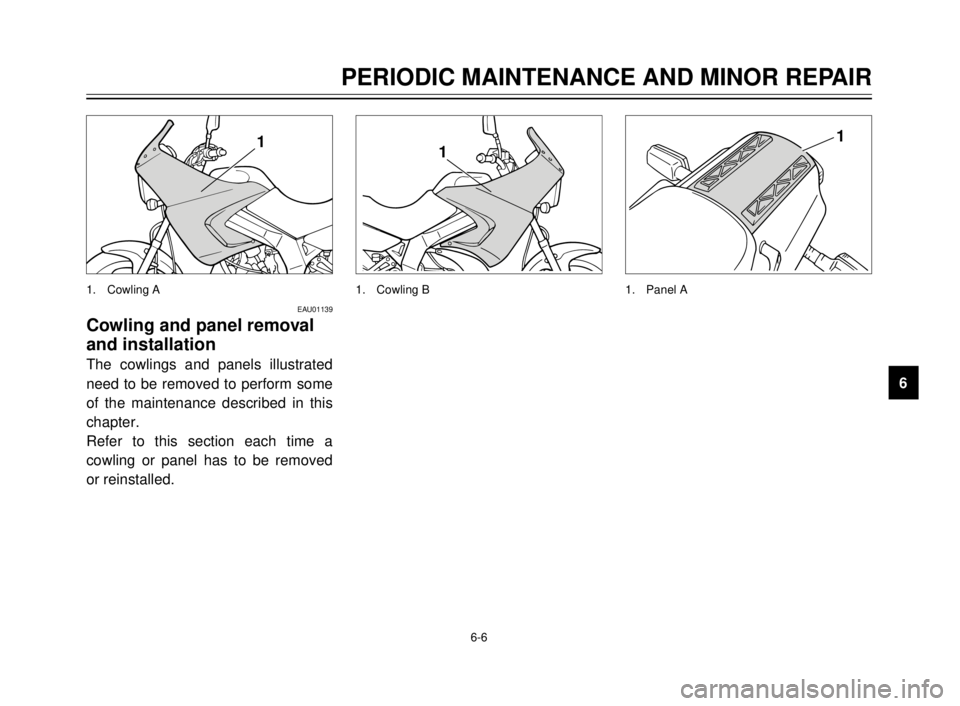
6-6
PERIODIC MAINTENANCE AND MINOR REPAIR
1
2
3
4
5
6
7
8
9
1
1. Cowling B
1
1. Panel A
EAU01139
Cowling and panel removal
and installation
The cowlings and panels illustrated
need to be removed to perform some
of the maintenance described in this
chapter.
Refer to this section each time a
cowling or panel has to be removed
or reinstalled.
1
1. Cowling A
5AE-9-E3 (ENG) 4/11/0 11:06 AM Page 49
Page 52 of 104
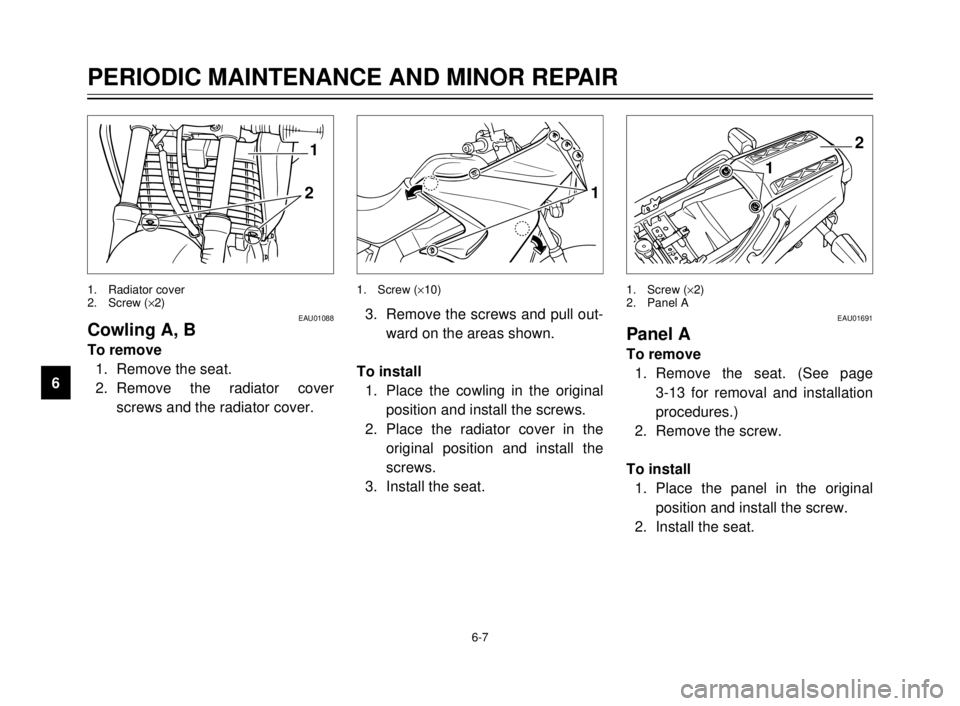
6-7
2
1
1
12
EAU01088Cowling A, B
To remove
1. Remove the seat.
2. Remove the radiator cover
screws and the radiator cover.
1. Radiator cover
2. Screw (´2)1. Screw (´10) 1. Screw (´2)
2. Panel A
3. Remove the screws and pull out-
ward on the areas shown.
To install
1. Place the cowling in the original
position and install the screws.
2. Place the radiator cover in the
original position and install the
screws.
3. Install the seat.EAU01691
Panel A
To remove
1. Remove the seat. (See page
3-13 for removal and installation
procedures.)
2. Remove the screw.
To install
1. Place the panel in the original
position and install the screw.
2. Install the seat.
PERIODIC MAINTENANCE AND MINOR REPAIR
1
2
3
4
5
6
7
8
9
5AE-9-E3 (ENG) 4/11/0 11:06 AM Page 50
Page 53 of 104
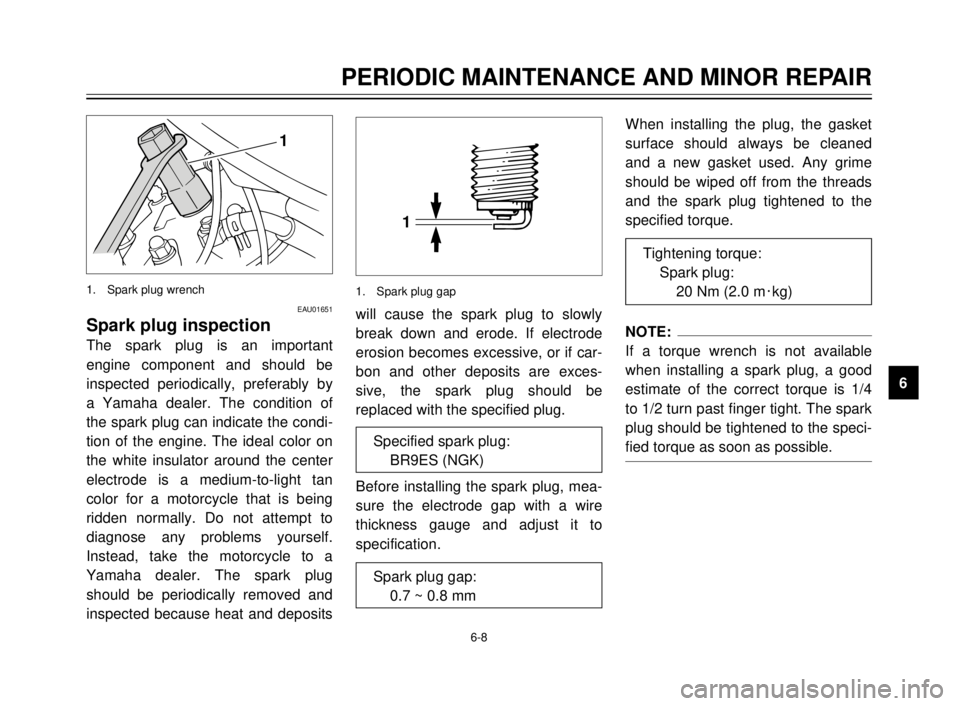
6-8
1
EAU01651
Spark plug inspection
The spark plug is an important
engine component and should be
inspected periodically, preferably by
a Yamaha dealer. The condition of
the spark plug can indicate the condi-
tion of the engine. The ideal color on
the white insulator around the center
electrode is a medium-to-light tan
color for a motorcycle that is being
ridden normally. Do not attempt to
diagnose any problems yourself.
Instead, take the motorcycle to a
Yamaha dealer. The spark plug
should be periodically removed and
inspected because heat and depositswill cause the spark plug to slowly
break down and erode. If electrode
erosion becomes excessive, or if car-
bon and other deposits are exces-
sive, the spark plug should be
replaced with the specified plug.
Before installing the spark plug, mea-
sure the electrode gap with a wire
thickness gauge and adjust it to
specification.When installing the plug, the gasket
surface should always be cleaned
and a new gasket used. Any grime
should be wiped off from the threads
and the spark plug tightened to the
specified torque.NOTE:
If a torque wrench is not available
when installing a spark plug, a good
estimate of the correct torque is 1/4
to 1/2 turn past finger tight. The spark
plug should be tightened to the speci-
fied torque as soon as possible.
1. Spark plug wrench
PERIODIC MAINTENANCE AND MINOR REPAIR
1
2
3
4
5
6
7
8
9 Specified spark plug:
BR9ES (NGK)
Spark plug gap:
0.7 ~ 0.8 mm
Tightening torque:
Spark plug:
20 Nm (2.0 m0kg)
1
1. Spark plug gap
5AE-9-E3 (ENG) 4/11/0 11:06 AM Page 51
Page 54 of 104
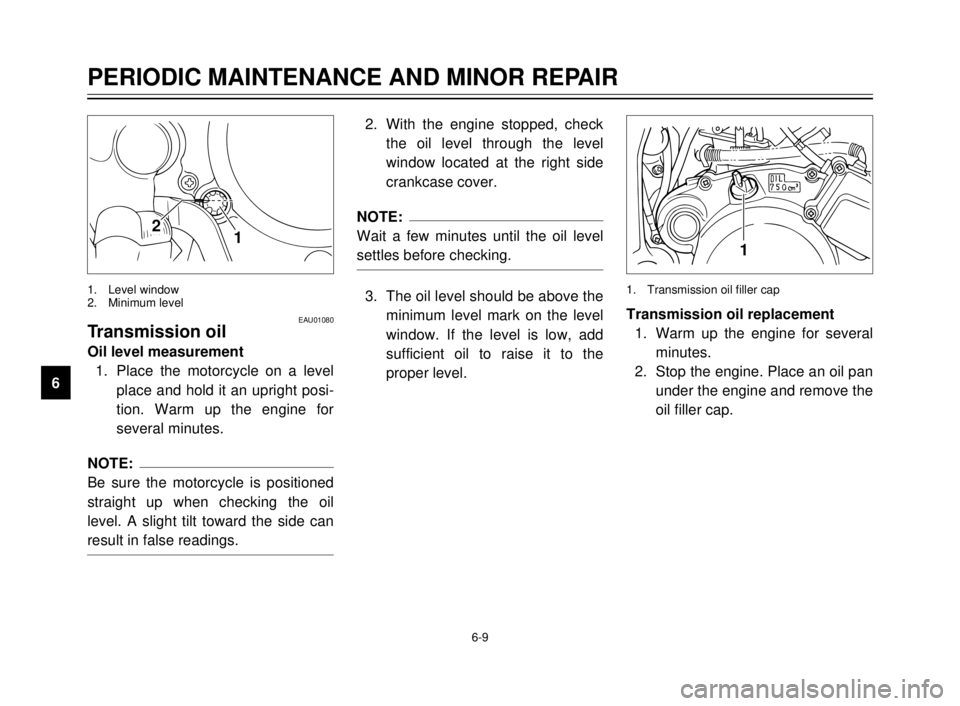
6-9
1
1. Transmission oil filler cap
2. With the engine stopped, check
the oil level through the level
window located at the right side
crankcase cover.
NOTE:
Wait a few minutes until the oil level
settles before checking.
3. The oil level should be above the
minimum level mark on the level
window. If the level is low, add
sufficient oil to raise it to the
proper level.Transmission oil replacement
1. Warm up the engine for several
minutes.
2. Stop the engine. Place an oil pan
under the engine and remove the
oil filler cap.
PERIODIC MAINTENANCE AND MINOR REPAIR
1
2
3
4
5
6
7
8
9
12
EAU01080Transmission oil
Oil level measurement
1. Place the motorcycle on a level
place and hold it an upright posi-
tion. Warm up the engine for
several minutes.
NOTE:
Be sure the motorcycle is positioned
straight up when checking the oil
level. A slight tilt toward the side can
result in false readings.
1. Level window
2. Minimum level
5AE-9-E3 (ENG) 4/11/0 11:06 AM Page 52
Page 55 of 104
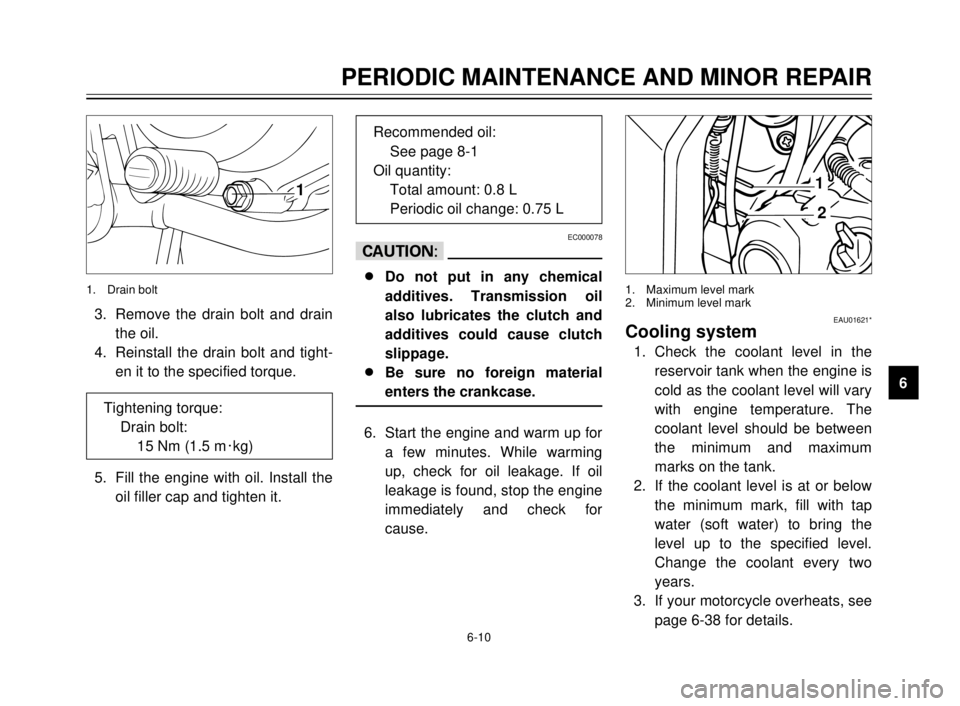
6-10
1
3. Remove the drain bolt and drain
the oil.
4. Reinstall the drain bolt and tight-
en it to the specified torque.
5. Fill the engine with oil. Install the
oil filler cap and tighten it.
EC000078
cC
8
8
Do not put in any chemical
additives. Transmission oil
also lubricates the clutch and
additives could cause clutch
slippage.
8 8
Be sure no foreign material
enters the crankcase.
6. Start the engine and warm up for
a few minutes. While warming
up, check for oil leakage. If oil
leakage is found, stop the engine
immediately and check for
cause.
1. Drain bolt
PERIODIC MAINTENANCE AND MINOR REPAIR
1
2
3
4
5
6
7
8
9 Tightening torque:
Drain bolt:
15 Nm (1.5 m0kg)
Recommended oil:
See page 8-1
Oil quantity:
Total amount: 0.8 L
Periodic oil change: 0.75 L
1
2
1. Maximum level mark
2. Minimum level mark
EAU01621*Cooling system
1. Check the coolant level in the
reservoir tank when the engine is
cold as the coolant level will vary
with engine temperature. The
coolant level should be between
the minimum and maximum
marks on the tank.
2. If the coolant level is at or below
the minimum mark, fill with tap
water (soft water) to bring the
level up to the specified level.
Change the coolant every two
years.
3. If your motorcycle overheats, see
page 6-38 for details.
5AE-9-E3 (ENG) 4/11/0 11:06 AM Page 53
Page 56 of 104
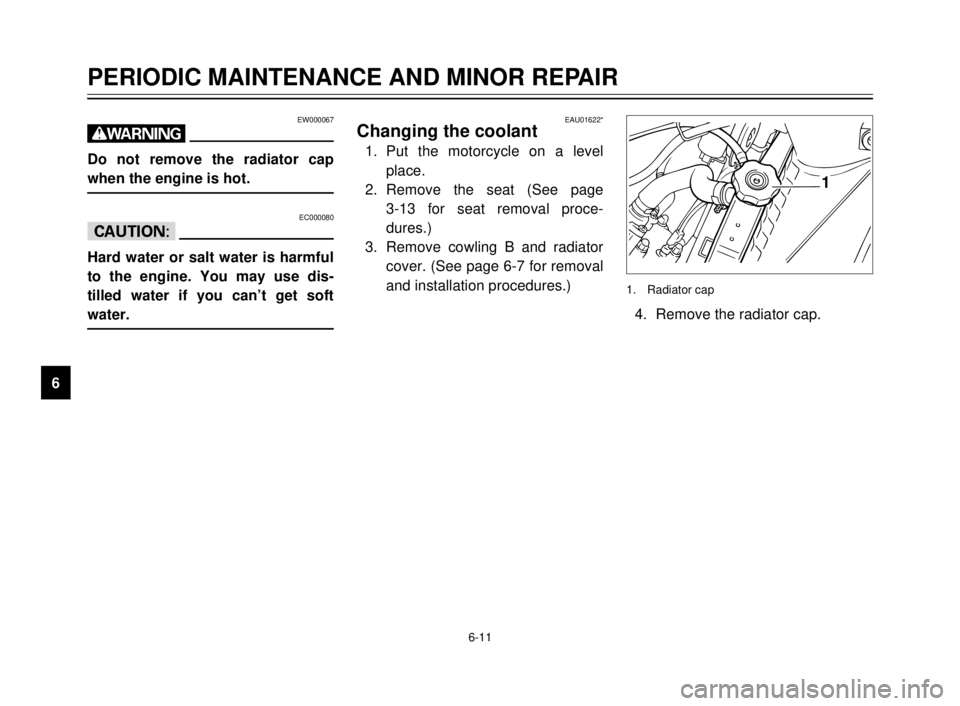
EAU01622*Changing the coolant
1. Put the motorcycle on a level
place.
2. Remove the seat (See page
3-13 for seat removal proce-
dures.)
3. Remove cowling B and radiator
cover. (See page 6-7 for removal
and installation procedures.)
6-11
PERIODIC MAINTENANCE AND MINOR REPAIR
1
2
3
4
5
6
7
8
94. Remove the radiator cap.
EW000067
w
Do not remove the radiator cap
when the engine is hot.
EC000080
cC
Hard water or salt water is harmful
to the engine. You may use dis-
tilled water if you can’t get soft
water.
1
1. Radiator cap
5AE-9-E3 (ENG) 4/11/0 11:06 AM Page 54
Page 57 of 104
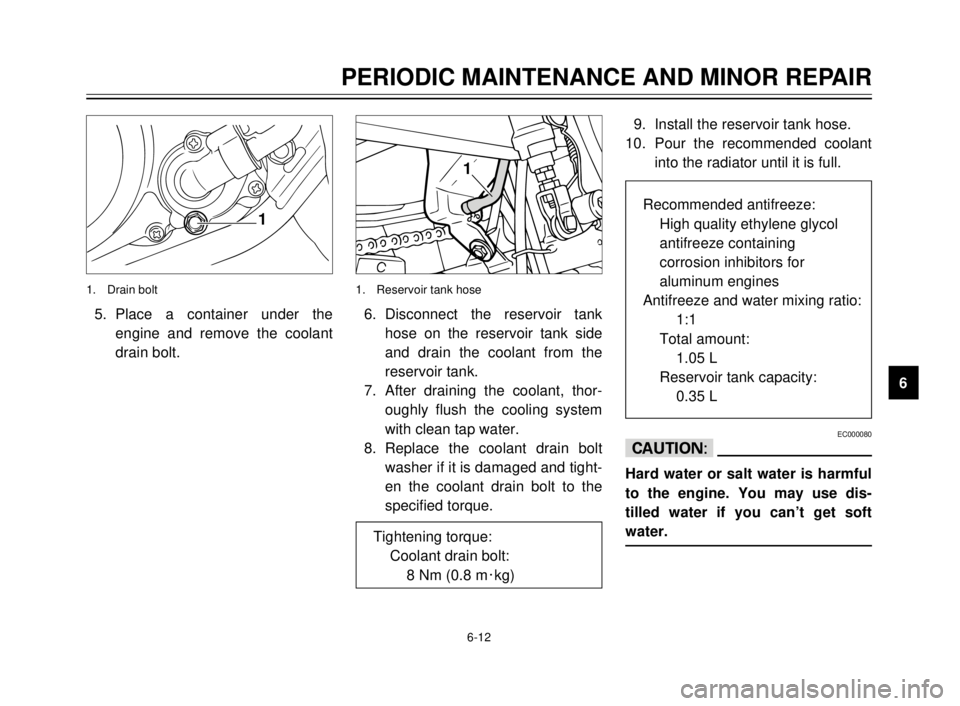
6-12
PERIODIC MAINTENANCE AND MINOR REPAIR
1
2
3
4
5
6
7
8
9
1
5. Place a container under the
engine and remove the coolant
drain bolt.
1. Drain bolt
1
6. Disconnect the reservoir tank
hose on the reservoir tank side
and drain the coolant from the
reservoir tank.
7. After draining the coolant, thor-
oughly flush the cooling system
with clean tap water.
8. Replace the coolant drain bolt
washer if it is damaged and tight-
en the coolant drain bolt to the
specified torque.
1. Reservoir tank hose
Tightening torque:
Coolant drain bolt:
8 Nm (0.8 m0kg)
9. Install the reservoir tank hose.
10. Pour the recommended coolant
into the radiator until it is full.
EC000080
cC
Hard water or salt water is harmful
to the engine. You may use dis-
tilled water if you can’t get soft
water.
Recommended antifreeze:
High quality ethylene glycol
antifreeze containing
corrosion inhibitors for
aluminum engines
Antifreeze and water mixing ratio:
1:1
Total amount:
1.05 L
Reservoir tank capacity:
0.35 L
5AE-9-E3 (ENG) 4/11/0 11:06 AM Page 55
Page 58 of 104
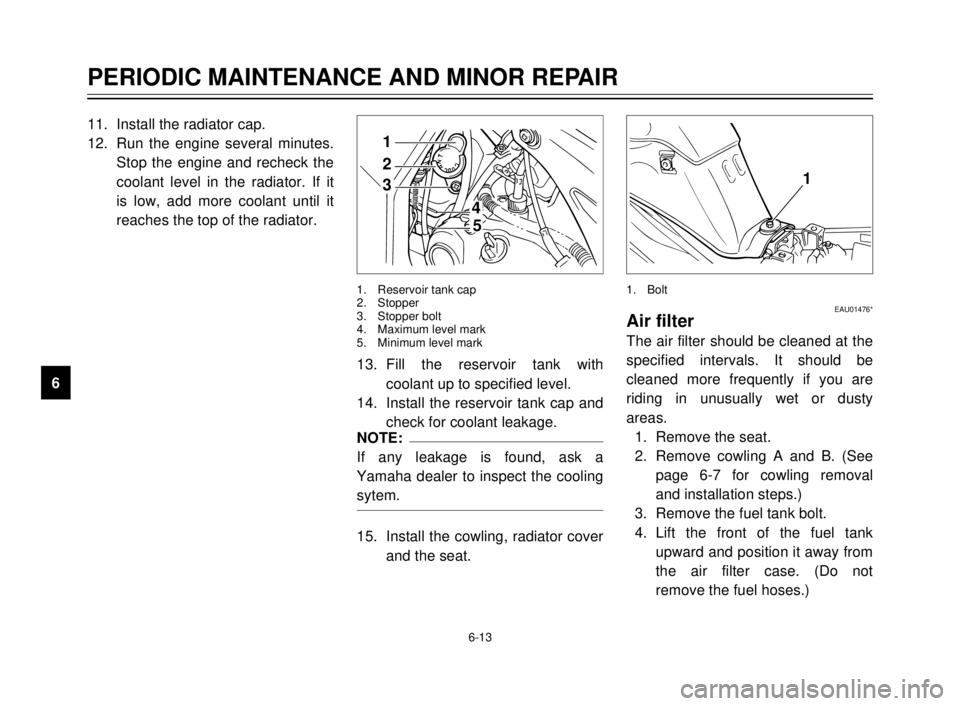
6-13
PERIODIC MAINTENANCE AND MINOR REPAIR
1
2
3
4
5
6
7
8
9
2
1
4
5
3
1. Reservoir tank cap
2. Stopper
3. Stopper bolt
4. Maximum level mark
5. Minimum level mark
11. Install the radiator cap.
12. Run the engine several minutes.
Stop the engine and recheck the
coolant level in the radiator. If it
is low, add more coolant until it
reaches the top of the radiator.
13. Fill the reservoir tank with
coolant up to specified level.
14. Install the reservoir tank cap and
check for coolant leakage.
NOTE:
If any leakage is found, ask a
Yamaha dealer to inspect the cooling
sytem.
15. Install the cowling, radiator cover
and the seat.
1
EAU01476*Air filter
The air filter should be cleaned at the
specified intervals. It should be
cleaned more frequently if you are
riding in unusually wet or dusty
areas.
1. Remove the seat.
2. Remove cowling A and B. (See
page 6-7 for cowling removal
and installation steps.)
3. Remove the fuel tank bolt.
4. Lift the front of the fuel tank
upward and position it away from
the air filter case. (Do not
remove the fuel hoses.)
1. Bolt
5AE-9-E3 (ENG) 4/11/0 11:06 AM Page 56
Page 59 of 104
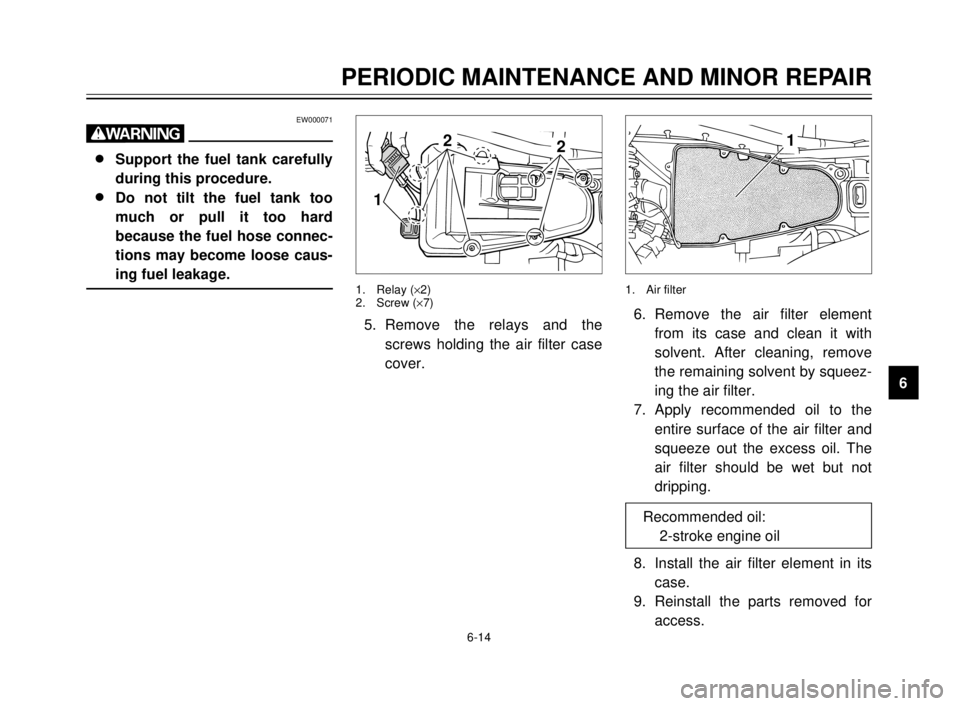
6-14
PERIODIC MAINTENANCE AND MINOR REPAIR
1
2
3
4
5
6
7
8
9
EW000071
w
8 8
Support the fuel tank carefully
during this procedure.
8 8
Do not tilt the fuel tank too
much or pull it too hard
because the fuel hose connec-
tions may become loose caus-
ing fuel leakage.
1
2
2
1. Relay (´2)
2. Screw (´7)
5. Remove the relays and the
screws holding the air filter case
cover.
1
1. Air filter
6. Remove the air filter element
from its case and clean it with
solvent. After cleaning, remove
the remaining solvent by squeez-
ing the air filter.
7. Apply recommended oil to the
entire surface of the air filter and
squeeze out the excess oil. The
air filter should be wet but not
dripping.
8. Install the air filter element in its
case.
9. Reinstall the parts removed for
access. Recommended oil:
2-stroke engine oil
5AE-9-E3 (ENG) 4/11/0 11:06 AM Page 57
Page 60 of 104
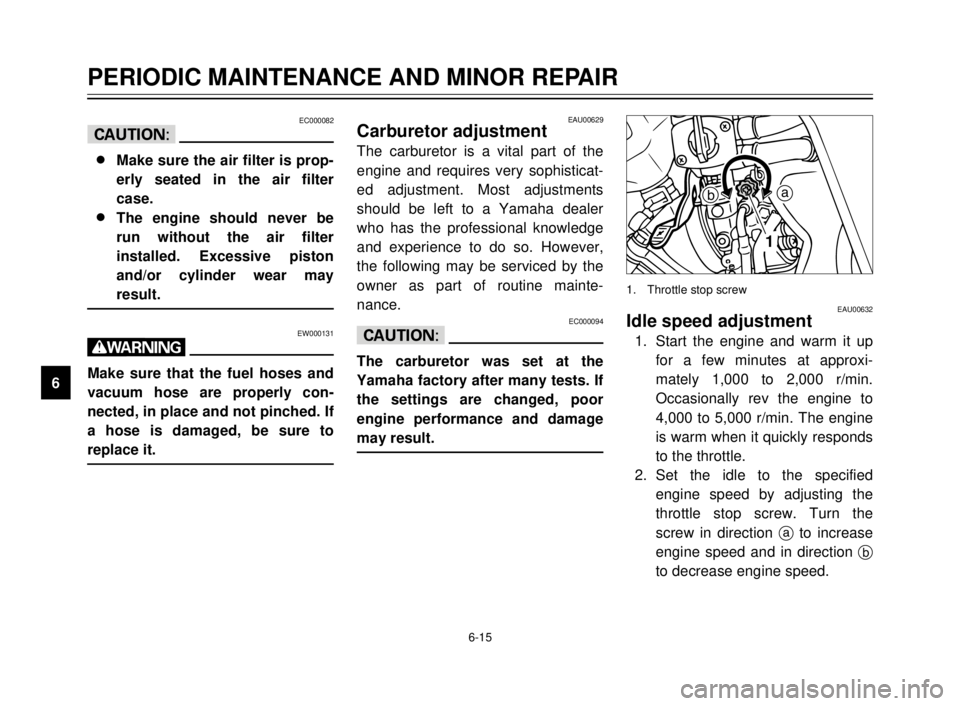
6-15
PERIODIC MAINTENANCE AND MINOR REPAIR
1
2
3
4
5
6
7
8
9
EC000082
cC
8
8
Make sure the air filter is prop-
erly seated in the air filter
case.
8 8
The engine should never be
run without the air filter
installed. Excessive piston
and/or cylinder wear may
result.
EW000131
w
Make sure that the fuel hoses and
vacuum hose are properly con-
nected, in place and not pinched. If
a hose is damaged, be sure to
replace it.
EAU00629Carburetor adjustment
The carburetor is a vital part of the
engine and requires very sophisticat-
ed adjustment. Most adjustments
should be left to a Yamaha dealer
who has the professional knowledge
and experience to do so. However,
the following may be serviced by the
owner as part of routine mainte-
nance.
EC000094
cC
The carburetor was set at the
Yamaha factory after many tests. If
the settings are changed, poor
engine performance and damage
may result.
ba
1
EAU00632Idle speed adjustment
1. Start the engine and warm it up
for a few minutes at approxi-
mately 1,000 to 2,000 r/min.
Occasionally rev the engine to
4,000 to 5,000 r/min. The engine
is warm when it quickly responds
to the throttle.
2. Set the idle to the specified
engine speed by adjusting the
throttle stop screw. Turn the
screw in direction ato increase
engine speed and in direction b
to decrease engine speed.
1. Throttle stop screw
5AE-9-E3 (ENG) 4/11/0 11:06 AM Page 58